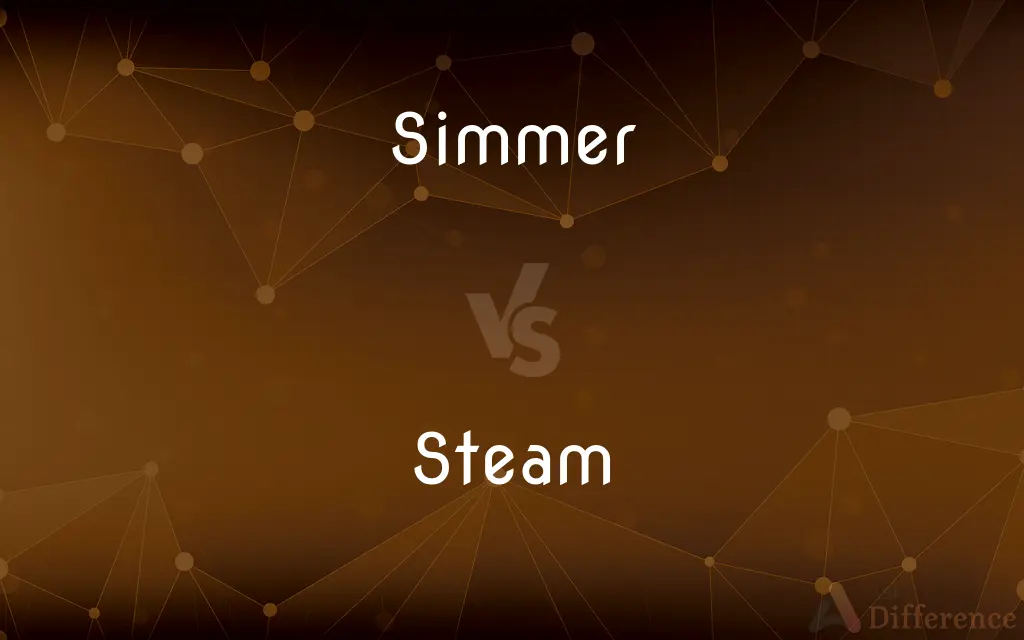Simmer vs. Steam — What's the Difference?
By Tayyaba Rehman & Maham Liaqat — Updated on March 22, 2024
Simmering involves cooking food in liquid just below the boiling point, ensuring gentle cooking, while steaming cooks food with steam from boiling water, preserving nutrients and texture.

Difference Between Simmer and Steam
Table of Contents
ADVERTISEMENT
Key Differences
Simmering is a cooking technique where food is cooked in liquid kept just below its boiling point, typically around 180-205°F. This method is ideal for dishes like soups and stews, where gentle cooking is necessary to tenderize meat and integrate flavors. On the other hand, steaming involves cooking food by exposing it to steam, usually from boiling water, in a closed environment like a steamer basket over a pot. This method is highly effective for vegetables and seafood, preserving their texture, color, and nutrients that might be lost in water.
Simmered dishes often require longer cooking times due to the lower temperature, allowing flavors to meld and ingredients to become tender without falling apart. Whereas, steaming cooks food more quickly because it uses the high heat of steam, which efficiently transfers heat to the food, cooking it evenly and rapidly.
In simmering, the food is in direct contact with the liquid, which can lead to some nutrients being leached out into the water. However, this can also be an advantage if the liquid, such as a broth or sauce, is part of the dish's serving. Steam cooking, however, generally retains more of the food's original nutrients and flavor since the food does not come into direct contact with the liquid, preventing nutrients from being dissolved away.
Simmering can sometimes result in a richer flavor for the cooked food, as the process allows for the extraction of flavors from ingredients into the liquid. In contrast, steaming is often considered a healthier cooking method because it minimizes the loss of vitamins and minerals and does not require oils or fats, making it a better option for those looking to reduce calorie intake.
While both methods are excellent for making food tender, the choice between simmering and steaming may come down to the desired texture and flavor of the dish. Simmering is suited for breaking down tougher cuts of meat and for dishes where a flavorful broth or sauce is desired, while steaming is best for preserving the natural taste and firmness of ingredients.
ADVERTISEMENT
Comparison Chart
Temperature
Just below boiling point (180-205°F)
At or above boiling point (212°F)
Cooking Medium
In liquid
Above boiling water, exposed to steam
Cooking Time
Longer, to integrate and enhance flavors
Shorter, efficient cooking preserving nutrients
Nutrient Retention
Lower, as some nutrients may leach into liquid
Higher, minimal nutrient loss
Flavor
Can enhance by absorbing flavors from the liquid
Preserves original flavors, minimal flavor loss
Ideal For
Soups, stews, tenderizing tough meats
Vegetables, seafood, delicate foods
Texture
Tender, can be more integrated with liquid
More crisp, retains original texture
Health Aspect
Can be rich in flavor, may use fats
Healthier, no need for added fats
Compare with Definitions
Simmer
Cooking food gently in liquid just below boiling.
Simmering the chicken soup slowly enhances its flavor.
Steam
Quick and efficient, preserving texture.
Steam fish fillets for a moist and tender meal.
Simmer
Suitable for dishes where liquid is a component.
Simmer the vegetables in broth for a flavorful soup.
Steam
Retains food's natural flavor and color.
Steam green beans to keep their vibrant color and crisp texture.
Simmer
Involves cooking for longer periods.
Simmer the chili for hours to meld the spices well.
Steam
Cooking food by exposing it to steam.
Steam the broccoli to preserve its nutrients and color.
Simmer
Ideal for integrating flavors and tenderizing.
Simmer the beef to make it tender for the stew.
Steam
No direct contact with water, preventing nutrient loss.
Steam carrots instead of boiling to maintain their vitamin content.
Simmer
Requires lower heat to avoid boiling.
Keep the flame low to simmer the sauce without burning it.
Steam
Suitable for health-conscious cooking methods.
Steam dumplings for a lighter, healthier option.
Simmer
To be cooked gently or remain just at or below the boiling point.
Steam
Steam is water in the gas phase. This may occur due to evaporation or due to boiling, where heat is applied until water reaches the enthalpy of vaporization.
Simmer
To be filled with pent-up emotion
Simmer with resentment.
Steam
The vapour into which water is converted when heated, forming a white mist of minute water droplets in the air
A cloud of steam
She wiped the steam off the mirror
Steam was rising from the mugs of coffee
Simmer
To be in a state of mild agitation or turmoil
Resentment simmering between rivals.
Steam
Give off or produce steam
A mug of coffee was steaming at her elbow
Simmer
To develop in a slow or unexcited way
She let the idea for the novel simmer.
Steam
Cook (food) by heating it in steam from boiling water
Steam the vegetables until just tender
Simmer
(intransitive) To cook or undergo heating slowly at or below the boiling point.
The soup simmered on the stove.
Steam
(of a ship or train) travel somewhere under steam power
The 11.54 steamed into the station
Simmer
(transitive) To cause to cook or to cause to undergo heating slowly at or below the boiling point.
Simmer the soup for five minutes, then serve.
Steam
Be or become extremely agitated or angry
You got all steamed up over nothing!
After steaming behind the closed door in his office, he came out and screamed at her
Simmer
To be on the point of breaking out into anger; to be agitated.
Steam
Hot water vapor produced especially by boiling liquid water.
Simmer
To remain angry with someone or something past the point of exhaustion; to resign oneself to holding a grudge, especially after some failed attempts to resolve a situation.
I tried to get through to him; all that's left for me to do is simmer.
Steam
Hot, pressurized water vapor used for heating, cooking, or to provide mechanical power.
Simmer
To develop gradually, of an idea or plan.
Steam
Power generated by the expansion of boiling water as it turns to vapor
An engine at full steam.
Simmer
The state or process of simmering.
The kettle was kept on the simmer.
Steam
Steam heating.
Simmer
Someone who plays a sim (a simulation game), particularly The Sims.
Steam
Condensed water vapor in the form of a mist or cloud
The steam from the teakettle.
The steam of the oxen's breath in the cold air.
Simmer
To boil gently, or with a gentle hissing; to begin to boil.
I simmer as liquor doth on the fire before it beginneth to boil.
Steam
Power; energy
The fundraising effort ran out of steam.
Simmer
To cause to boil gently; to cook in liquid heated almost or just to the boiling point.
Steam
To produce or emit steam
The kettle is steaming. Let's make tea.
Simmer
Temperature just below the boiling point;
The stew remained at a simmer for hours
Steam
To become or rise up as steam
The rain steamed off the hot pavement.
Simmer
Boil slowly at low temperature;
Simmer the sauce
Simmering water
Steam
To become misted or covered with steam
The bathroom mirror steamed over.
Steam
To move by means of steam power.
Steam
(Informal) To become very angry; fume.
Steam
To expose to steam, as in cooking.
Steam
To cover or mist with steam
The windows are steamed up.
Steam
(Informal) To make angry
His laziness really steams me.
Steam
The vapor formed when water changes from the liquid phase to the gas phase.
Steam
The suspended condensate (cloud) formed by water vapour when it encounters colder air
Steam
, fog
Steam
Exhaled breath into cold air below the dew point of the exhalation
Steam
Pressurized water vapour used for heating, cooking, or to provide mechanical energy.
Steam
The act of cooking by steaming.
Give the carrots a ten-minute steam.
Steam
(figuratively) Internal energy for motive power.
After three weeks in bed he was finally able to sit up under his own steam.
Steam
(figuratively) Pent-up anger.
Dad had to go outside to blow off some steam.
Steam
A steam-powered vehicle.
Steam
Travel by means of a steam-powered vehicle.
Steam
(obsolete) Any exhalation.
Steam
(fencing) Fencing without the use of any electric equipment.
Steam
To cook with steam.
The best way to cook artichokes is to steam them.
Steam
(transitive) To expose to the action of steam; to apply steam to for softening, dressing, or preparing.
To steam wood or cloth
Steam
(intransitive) To produce or vent steam.
Steam
(intransitive) To rise in vapour; to issue, or pass off, as vapour.
Our breath steamed in the cold winter air.
Steam
To become angry; to fume; to be incensed.
Steam
To make angry.
It really steams me to see her treat him like that.
Steam
(intransitive) To be covered with condensed water vapor.
With all the heavy breathing going on the windows were quickly steamed in the car.
Steam
(intransitive) To travel by means of steam power.
We steamed around the Mediterranean.
The ship steamed out of the harbour.
Steam
To move with great or excessive purposefulness.
If he heard of anyone picking the fruit he would steam off and lecture them.
Steam
(obsolete) To exhale.
Steam
Old-fashioned; from before the digital age.
Steam
The elastic, aëriform fluid into which water is converted when heated to the boiling point; water in the state of vapor.
Steam
The mist formed by condensed vapor; visible vapor; - so called in popular usage.
Steam
Any exhalation.
Steam
To rise in vapor; to issue, or pass off, as vapor.
The dissolved amber . . . steamed away into the air.
Steam
To move or travel by the agency of steam.
The vessel steamed out of port.
Steam
To generate steam; as, the boiler steams well.
Steam
To exhale.
Steam
To expose to the action of steam; to apply steam to for softening, dressing, or preparing; as, to steam wood; to steamcloth; to steam food, etc.
Steam
Water at boiling temperature diffused in the atmosphere
Steam
Travel by means of steam power;
The ship steamed off into the Pacific
Steam
Emit steam;
The rain forest was literally steaming
Steam
Rise as vapor
Steam
Get very angry;
Her indifference to his amorous advances really steamed the young man
Steam
Clean by means of steaming;
Steam-clean the upholstered sofa
Steam
Cook something by letting steam pass over it;
Just steam the vegetables
Common Curiosities
What is simmering?
Simmering is cooking food gently in liquid just below its boiling point to tenderize and enhance flavors.
What is steaming?
Steaming is a method of cooking food by exposing it to steam, preserving nutrients, texture, and color.
How do I know if a liquid is simmering?
A liquid is simmering when it shows gentle, steady bubbles on the surface, not a rolling boil.
Is simmering the same as boiling?
No, simmering is cooking at a lower temperature than boiling, indicated by gentle bubbling.
Can I steam food without a steamer?
Yes, you can steam food using a colander or a heatproof dish over boiling water, covered with a lid.
Can all foods be simmered or steamed?
Most foods can be simmered or steamed, but the methods are particularly suited to vegetables, seafood, and tough cuts of meat.
Can I reuse the water from steaming?
Yes, the water from steaming can be reused in soups or watering plants, provided it's clean.
How long should I steam vegetables?
Steaming times vary by vegetable; most require between 3 to 10 minutes.
Is it necessary to stir while simmering?
Stirring depends on the dish; some require occasional stirring to prevent sticking.
Why is steaming considered healthier than simmering?
Steaming is healthier because it requires no added fats and preserves more nutrients.
Can simmering make food too soft?
Yes, over-simmering can break down foods too much, making them mushy.
Do I need to season food before steaming?
Seasoning before steaming can enhance flavor, though it's not always necessary.
What's the best way to steam without a steamer basket?
Use a colander or a heatproof plate over boiling water in a pot, covered with a lid.
How do I prevent food from sticking when simmering?
Use a non-stick pot or stir occasionally, ensuring the liquid covers the food.
Why might someone choose simmering over steaming?
Simmering is chosen for dishes where a rich, integrated flavor is desired, or for tenderizing tough meats.
Share Your Discovery

Previous Comparison
Diversify vs. Diversity
Next Comparison
Stinge vs. StingAuthor Spotlight
Written by
Tayyaba RehmanTayyaba Rehman is a distinguished writer, currently serving as a primary contributor to askdifference.com. As a researcher in semantics and etymology, Tayyaba's passion for the complexity of languages and their distinctions has found a perfect home on the platform. Tayyaba delves into the intricacies of language, distinguishing between commonly confused words and phrases, thereby providing clarity for readers worldwide.
Co-written by
Maham Liaqat













































